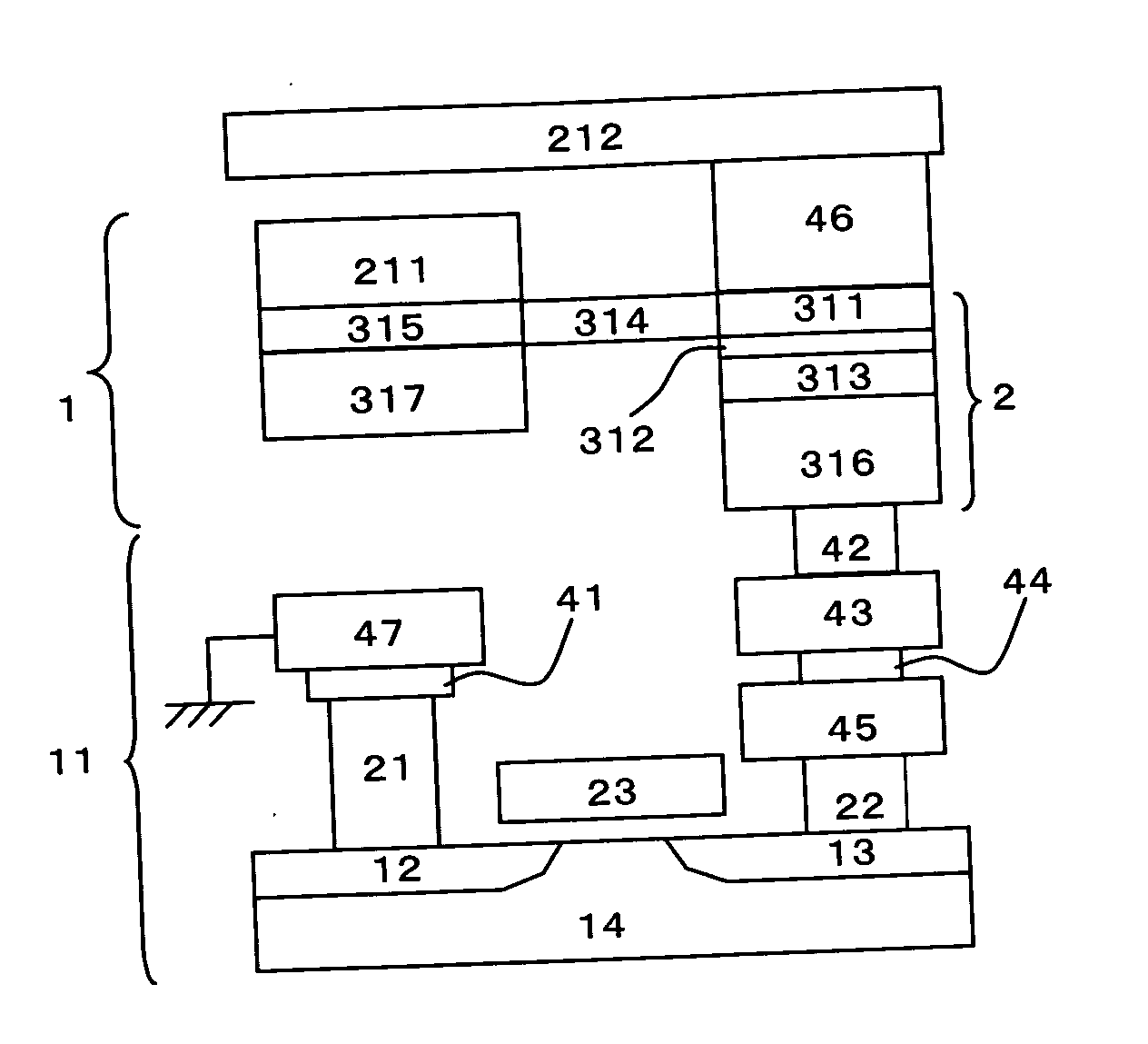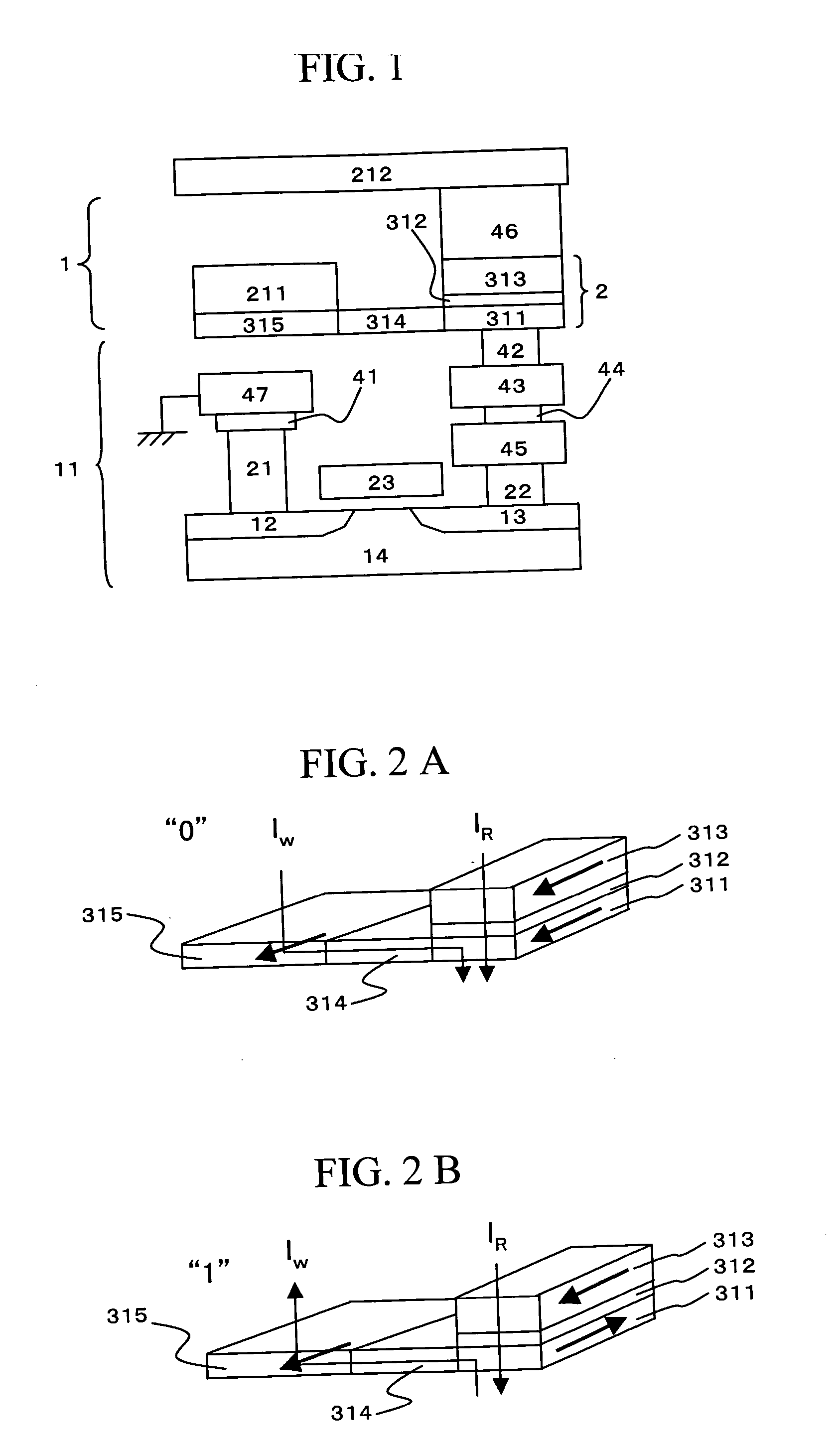Low power consumption magnetic memory and magnetic information recording device
a magnetic memory and low power consumption technology, applied in semiconductor devices, digital storage, instruments, etc., can solve the problem of not being able to drastically reduce the current which was necessary, and achieve the effect of reducing the threshold current, high output magnetic memory, and decreasing the demagnetizing field
- Summary
- Abstract
- Description
- Claims
- Application Information
AI Technical Summary
Benefits of technology
Problems solved by technology
Method used
Image
Examples
first embodiment
[0023]FIG. 1 is a cross-sectional schematic drawing illustrating an example of a configuration of a magnetic memory and a switching portion of a memory cell. A C-MOS transistor 11 consists of two n-type semiconductors 12 and 13 and a p-type semiconductor 14. The electrode 21 to be a drain is electrically connected to the n-type semiconductor 12 and connected to the ground through the electrode 41 and the electrode 47. The electrode 22 to be a source is connected to the n-type semiconductor 13. Moreover, 23 is a gate electrode, and on / off operation of the current flowing between the source electrode 22 and the drain electrode 21 is controlled by on / off operation of this gate electrode 23. The electrode 45, electrode 44, electrode 43, and electrode 42 are stacked on the source electrode 22, and the free layer 311 is connected to the electrode 42. The tunneling magnetoresistive element (TMR element) of the memory cell 1 consists of a stacked layer of the free layer 311, the insulation ...
second embodiment
[0030]FIG. 6 is a cross-sectional schematic drawing illustrating another example of a memory cell and a switching portion of a magnetic memory of the present invention. This embodiment corresponds to one in which the first anti-ferromagnetic layer 316 and the second anti-ferromagnetic layer 317 are stacked to fix the magnetization directions of the first pinned layer 313 and the second pinned layer 315, respectively, in one direction in the configuration of the memory cell 1 shown in FIG. 1.
[0031] In this embodiment, PtMn (12 nm) was used for the first anti-ferromagnetic layer 316 and the second anti-ferromagnetic layer 317. Herein, except for PtMn, FeMn and IrMn may be used for the anti-ferromagnetic layer. In this embodiment, since the magnetic domains of the pinned layer are controlled to be oriented in one direction due to the anti-ferromagnetic layer, parallel and anti-parallel states of the relative angle of the magnetization direction with the free layer can be achieved stab...
third embodiment
[0033]FIG. 8 is a cross-sectional schematic drawing illustrating another example of a memory cell and a switching portion of a magnetic memory of the present invention. This embodiment shows an example of the configuration, in which the first pinned layer 313 is formed on the transistor 11 side through the insulation barrier layer 312, in the configuration of the memory cell 1 shown in FIG. 1. A magnetic memory of this embodiment can be deposited without breaking the vacuum atmosphere in a manufacturing process of the magnetic memory portion and a high quality TMR element can be fabricated, so that the output of the read signal can be increased.
[0034]FIG. 9 shows an example illustrating a method of reading / writing magnetic information to the free layer 311. The method of reading / writing magnetic information is same as that of the first embodiment. When the magnetization direction of the free layer 311 of the TMR element 2 is made parallel to the magnetization direction of the first...
PUM
 Login to View More
Login to View More Abstract
Description
Claims
Application Information
 Login to View More
Login to View More - R&D
- Intellectual Property
- Life Sciences
- Materials
- Tech Scout
- Unparalleled Data Quality
- Higher Quality Content
- 60% Fewer Hallucinations
Browse by: Latest US Patents, China's latest patents, Technical Efficacy Thesaurus, Application Domain, Technology Topic, Popular Technical Reports.
© 2025 PatSnap. All rights reserved.Legal|Privacy policy|Modern Slavery Act Transparency Statement|Sitemap|About US| Contact US: help@patsnap.com



